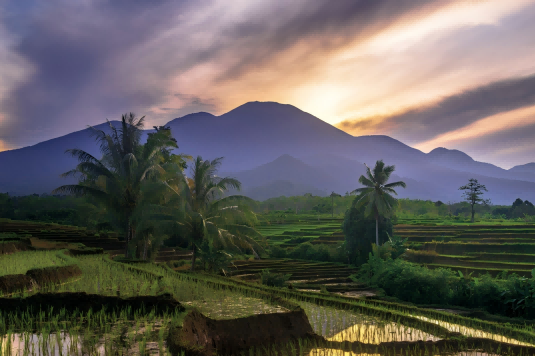
A triple whammy of accelerating sea level rise, ocean warming and acidification is imperilling Pacific Islands, which face growing threats to their socioeconomic viability and indeed their very existence because of climate change.
A scenic view of terraced rice fields with palm trees in the foreground and a mountain range under an illuminated, cloudy sky in the background.
The World Meteorological Organization (WMO) State of the Climate in the South-West Pacific 2023 report details how sea level rise in the region is above the global average. Sea surface temperatures have risen three times faster than the global average since 1980. During that time marine heatwaves have approximately doubled in frequency since 1980 and are more intense and are lasting longer.
The report was released by United Nations Secretary-General António Guterres and WMO Secretary-General Celeste Saulo at the Pacific Islands Forum in Tonga. It was accompanied by a special briefing document on Surging Seas in a Warming World, described by Mr Guterres as “an SOS on sea level rise.”
“A worldwide catastrophe is putting this Pacific paradise in peril,” said Mr Guterres.“ Global average sea levels are rising at an unprecedented rate. The ocean is overflowing.”
“The reason is clear: greenhouse gases – overwhelmingly generated by burning fossil fuels – are cooking our planet. And the sea is taking the heat – literally.”
Despite accounting for just 0.02 per cent of global emissions – the Pacific islands are uniquely exposed. Their average elevation is just one to two meters above sea level; 90 percent of the population live within 5 kilometres of the coast and half the infrastructure is within 500 metres of the sea, said Mr Guterres.
But the problem is global, he said.
“Surging seas are coming for us all – together with the devastation of fishing, tourism, and the Blue Economy. Across the world, around a billion people live in coastal areas threatened by our swelling ocean. Yet even though some sea level rise is inevitable, its scale, pace, and impact are not. That depends on our decisions,” said Mr Guterres, reiterating his urgent calls for drastic cuts in greenhouse gas emissions and increasing in climate adaptation.
The 53rd Pacific Island Forum Leaders Meeting’s host nation, the Kingdom of Tonga, is on the frontline of climate change and is exposed to hazards such as tropical cyclones and flooding. It also suffered a massive volcanic eruption which unleashed a basin-wide tsunami in January 2022 and caused a massive injection of water vapour into the Earth’s atmosphere, impacting the global climate.
“Climate change has become a global crisis and is the defining challenge that humanity currently faces. Communities, economies and ecosystems throughout the South-West Pacific region are significantly affected by its cascading impacts. It is increasingly evident that we are fast running out of time to turn the tide,” said WMO Secretary-General Celeste Saulo.
“The ocean has taken up more than 90 percent of the excess heat trapped by greenhouse gases and is undergoing changes which will be irreversible for centuries to come. Human activities have weakened the capacity of the ocean to sustain and protect us and – through sea level rise – are transforming a lifelong friend into a growing threat,” she said. “Already we are seeing more coastal flooding, shoreline retreat, saltwater contamination of freshwater supplies and displacement of communities.”
“WMO welcomes the Weather Ready Pacific Programme as part of the international Early Warnings for All initiative. Furthermore, the domino effects of the eruption of the Hunga Tonga-Hunga Ha’apai volcano highlight the need for multi-hazard early warnings against inter-connected and cascading risks,” she said.
Early warning systems facilitate proactive measures such as evacuation plans, resource allocation and infrastructure reinforcement. Even though they are a lifeline, they are available in only one third of Small Island Developing States globally, she said.
The State of the Climate in the South-West Pacific 2023 report was prepared in cooperation with National Meteorological and Hydrological Services, the United Nations Economic and Social Commission for Asia and the Pacific (ESCAP) and other United Nations agencies and international partners. It also looks at climate drivers in 2023 – including the last El Niño event – temperature, precipitation and extreme events like tropical cyclones, drought and extreme heat in the region.
Overall, 34 reported hydrometeorological hazard events in 2023 – most of them storm or flood related – led to over 200 fatalities and impacted more than 25 million people in the region.
Severe Tropical Cyclones Kevin and Judy were notable for making landfall on the island nation of Vanuatu within 48 hours of each other in March. Cyclone Lola, which made landfall in Vanuatu on 24 October, prompted the Government of Vanuatu to declare a six-month state of emergency in the affected provinces.
Tropical Cyclone Gabrielle brought significant rainfall, causing major impacts to the eastern North Island of New Zealand.in February 2023.
Elsewhere in the region, Typhoon Doksuri brought heavy rainfall and flooding to the Philippines in July 2023, claiming at least 45 lives and displacing almost 313 000 people.
Celeste Saulo will present a deeper dive into all aspects of the report at a three-day Forum convened by WMO and the Association of Southeast Asian Nations (ASEAN) Specialized Meteorological Centre (ASMC) in Singapore on 5 September 2024. The report will inform discussions at the event, entitled Towards a Weather-Ready and Climate Resilient ASEAN).
Reference: https://wmo.int/media/news/climate-change-transforms-pacific-islands
 Tel:+86-400 961 6990 Email:info@healthyphoton.com
Add:Room 305, Building 1, Zhongchuang Science Park, Jinyuan Road, Panhuo Street, Yinzhou District, Ningbo City,China
Tel:+86-400 961 6990 Email:info@healthyphoton.com
Add:Room 305, Building 1, Zhongchuang Science Park, Jinyuan Road, Panhuo Street, Yinzhou District, Ningbo City,China


